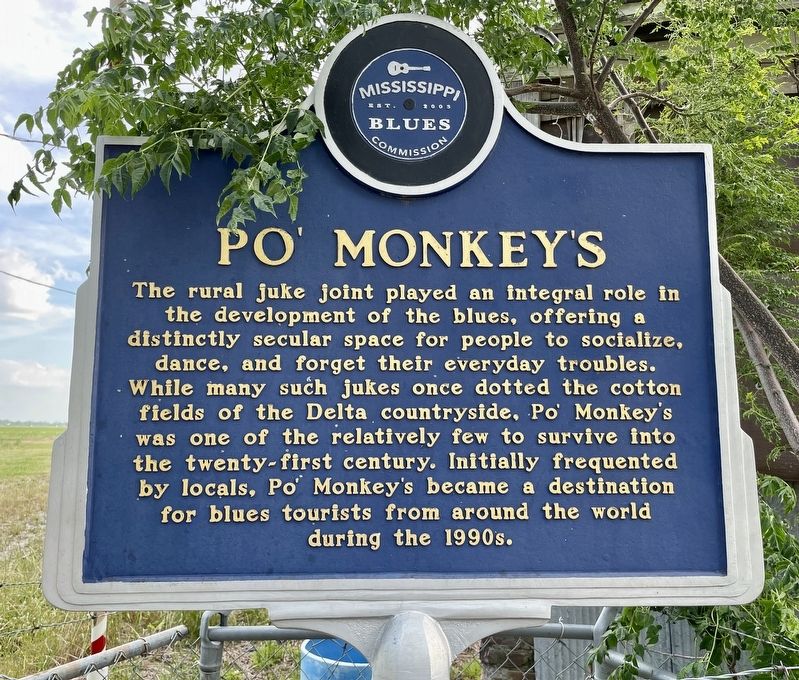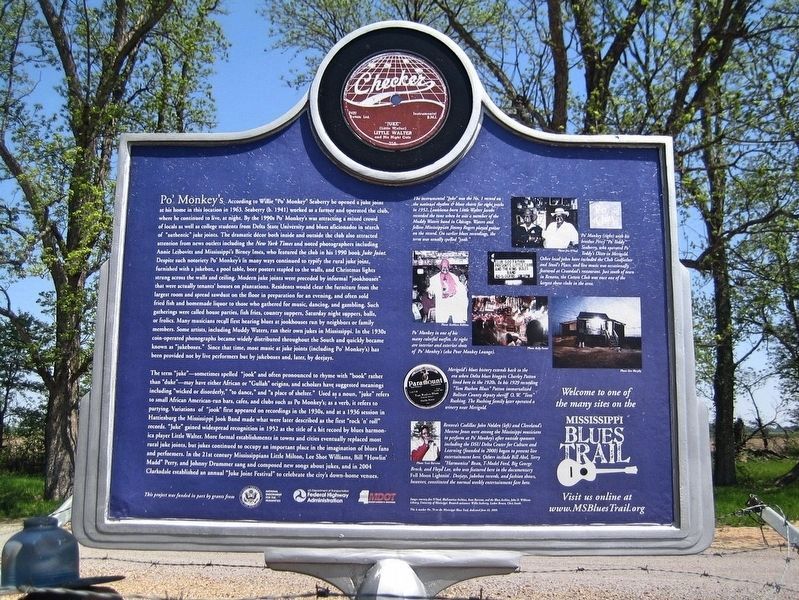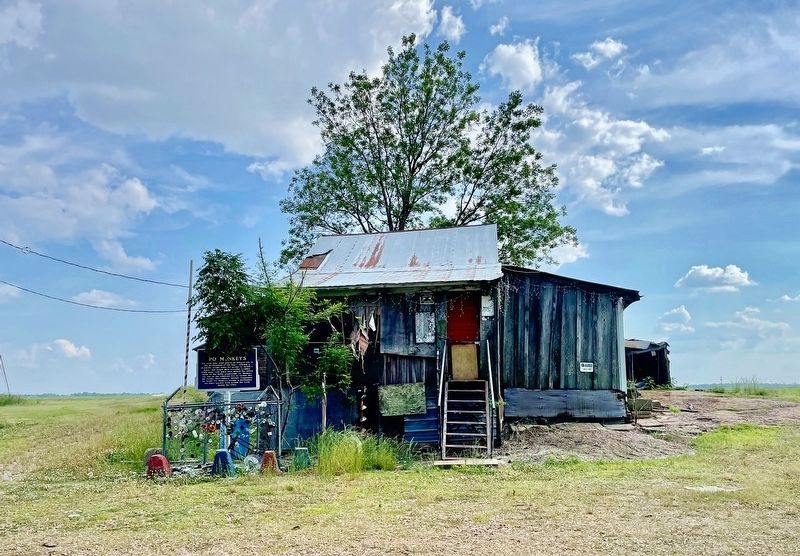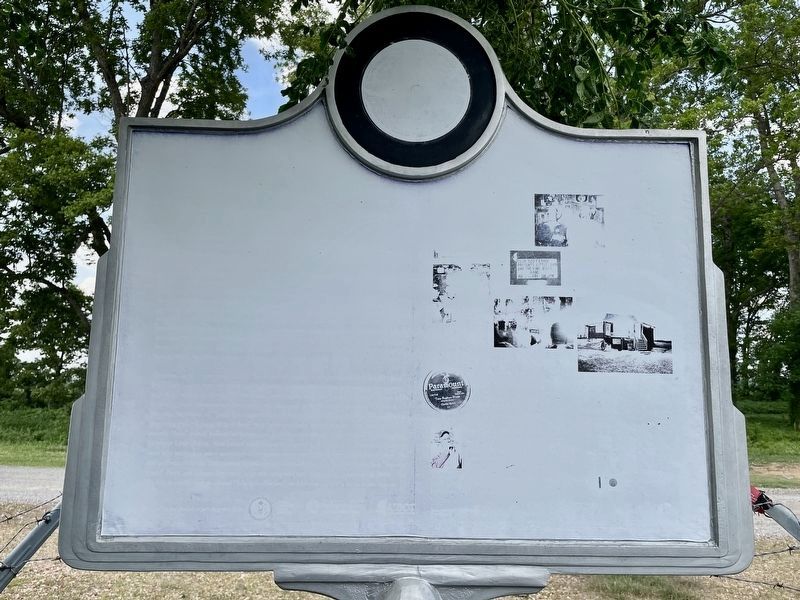Near Merigold in Bolivar County, Mississippi — The American South (East South Central)
Po' Monkey's
— Mississippi Blues Trail —
Po' Monkey's According to Willie “Po’ Monkey” Seaberry he opened a juke joint at his home in this location in 1963. Seaberry (b. 1941) worked as a farmer and operated the club, where he continued to live, at night. By the 1990s Po’ Monkey’s was attracting a mixed crowd of locals as well as college students from Delta State University and blues aficionados in search of “authentic” juke joints. The dramatic décor both inside and outside the club also attracted attention from news outlets including the New York Times and noted photographers including Annie Leibovitz and Mississippi’s Birney Imes, who featured the club in his 1990 book Juke Joint. Despite such notoriety Po’ Monkey’s in many ways continued to typify the rural juke joint, furnished with a jukebox, a pool table, beer posters stapled to the walls, and Christmas lights strung across the walls and ceiling. Modern juke joints were preceded by informal “jookhouses” that were actually tenants’ houses on plantations. Residents would clear the furniture from the largest room and spread sawdust on the floor in preparation for an evening, and often sold fried fish and homemade liquor to those who gathered for music, dancing, and gambling. Such gatherings were called house parties, fish fries, country suppers, Saturday night suppers, balls, or frolics. Many musicians recall first hearing blues at jookhouses run by neighbors or family members. Some artists, including Muddy Waters, ran their own jukes in Mississippi. In the 1930s coin-operated phonographs became widely distributed throughout the South and quickly became known as “jukeboxes.” Since that time, most music at juke joints (including Po’ Monkey’s) has been provided not by live performers but by jukeboxes and, later, by deejays.
The term “juke”—sometimes spelled “jook” and often pronounced to rhyme with “book” rather than “duke”—may have either African or “Gullah” origins, and scholars have suggested meanings including “wicked or disorderly,” “to dance,” and “a place of shelter.” Used as a noun, “juke” refers to small African American-run bars, cafes, and clubs such as Po Monkey’s; as a verb, it refers to partying. Variations of “jook” first appeared on recordings in the 1930s, and at a 1936 session in Hattiesburg the
Mississippi Jook Band made what were later described as the first “rock ’n’ roll” records. “Juke” gained widespread recognition in 1952 as the title of a hit record by blues harmonica player Little Walter. More formal establishments in towns and cities eventually replaced most rural juke joints, but jukes continued to occupy an important place in the imagination of blues fans and performers. In the 21st century Mississippians Little Milton, Lee Shot Williams, Bill “Howlin’ Madd” Perry, and Johnny Drummer sang and composed new songs about jukes, and in 2004 Clarksdale established an annual “Juke Joint Festival” to celebrate the city’s down-home venues.
Erected 2009 by the Mississippi Blues Commission. (Marker Number 79.)
Topics. This historical marker is listed in this topic list: Entertainment. A significant historical year for this entry is 1963.
Location. 33° 49.909′ N, 90° 45.495′ W. Marker is near Merigold, Mississippi, in Bolivar County. Marker is on Po Monkey Road, 1.4 miles west of U.S. 61/278, on the left when traveling west. Touch for map. Marker is at or near this postal address: 99 Po Monkey Rd, Merigold MS 38759, United States of America. Touch for directions.
Other nearby markers. At least 8 other markers are within 4 miles of this marker, measured as the crow flies. AKA Mobile Health Project (approx. 3.4 miles away); Delta Health Center (approx. 3½ miles away);
a different marker also named AKA Mobile Health Project (approx. 3½ miles away); Newton (Keys) Hotel Site (approx. 3.7 miles away); Mound Bayou Blues (approx. 3.7 miles away); Taborian Hospital (approx. 3.8 miles away); Mound Bayou (approx. 3.8 miles away); Site of Mound Bayou Oil Mill & Manufacturing Company (approx. 3.8 miles away).
Regarding Po' Monkey's. Po' Monkey's closed in 2016 following the death of its proprietor, Willie Seaberry. The contents including the interior and exterior signs, stuffed animals that hung from the ceiling, booths, an old sound system, Mardi Gras beads—which are all part of Seaberry’s estate, were sold at auction in 2018 to farmland investor Shonda Warner, a one-time resident of Clarksdale who frequently went to Po’ Monkey’s when she lived in the Delta.
Also see . . . Wikipedia article on Po' Monkey's. (Submitted on May 27, 2021, by Mark Hilton of Montgomery, Alabama.)
Credits. This page was last revised on July 31, 2023. It was originally submitted on May 27, 2021, by Mark Hilton of Montgomery, Alabama. This page has been viewed 462 times since then and 63 times this year. Photos: 1. submitted on May 27, 2021, by Mark Hilton of Montgomery, Alabama. 2. submitted on May 29, 2021, by Mark Hilton of Montgomery, Alabama. 3, 4. submitted on May 27, 2021, by Mark Hilton of Montgomery, Alabama.



